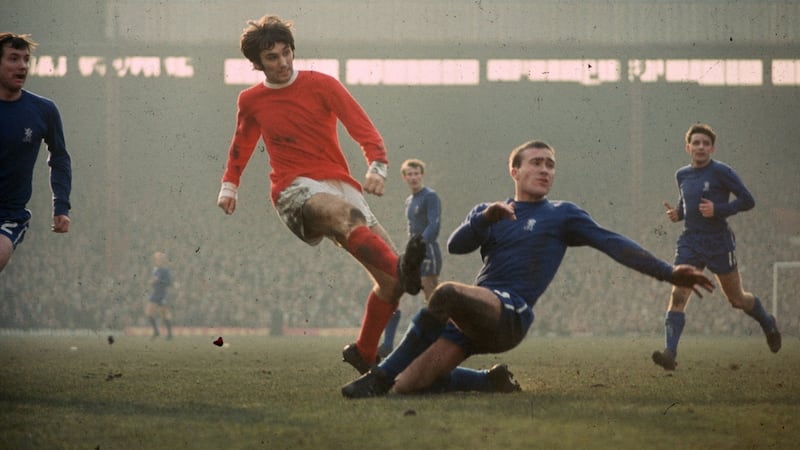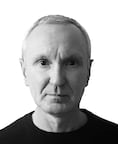He could have been 75 on Saturday; he should have been 75 on Saturday. It would have been a big deal, the red and green memories; his ears would have burned. But George Best had a tendency for early departure – from Belfast, from Manchester United, from women, from football altogether – and he left us early on a snowy November morning 16 years ago. He had not made 60, never mind 75.
What a tragedy, what a waste, all of that was said. And it was true and it was heartfelt. But it was part of the spontaneous wave of grief emanating from the Cregagh estate in east Belfast and washing all across these islands into Europe and beyond. It told a story of how Best affected people in a way that few sportsmen or singers or writers do. He touched those who watched him in a way that felt personal. I saw George Best – fathers took their children along to Old Trafford so one day they could say it. Alan McLoughlin’s father was one of them.
It was about pride and place, the sheer thrill of being there. It was about witnessing a fragile beauty develop into a formidable artist. George Best was no flash in the pan, he was in the first team at Old Trafford for 11 seasons. He played 470 games for United and scored 179 goals, a few of them the greatest the stadium has ever seen. Who lobs Pat Jennings? The one against Chelsea when he stays on his feet while Ron Harris chops at him?
This was a man of substance. Best was European Footballer of the Year in 1968, aged 21 going on 22. He was the youngest ever winner. He remained so until 1997 when the Brazilian Ronaldo came along at the same age. Like Ronaldo, Best had electric feet and balletic natural balance. But Best played on worse pitches, with lenient referees and against defenders like Harris who, when not kicking, could neutralise play by simply passing back to the goalkeeper. It was a different game for attackers.

When it comes to Best, though, too often the focus is on the after-show. He had the looks and one-liners to go with the ability.
“I often went missing. Miss World, Miss England, Miss Wales . . .”
“I spent a lot of money on booze, birds and fast cars. The rest I just squandered.”
The public laughed. It served him well – financially.
Best was a cottage industry at 21. It has not stopped 16 years after his death. There is another biography out, there is the George Best hotel (unopened) in the middle of Belfast, there is the airport, there is a new Best walking tour in Manchester – beginning today. Next week BT Sport show a new Best documentary.
We buy it: the Best stamp from the UK post office; the Best fiver from the Ulster Bank; mugs, T-shirts, framed photographs. There was a recent article in France Football, there was a piece in Gazzetta dello Sport last week. George is gone but his show goes on.
Yet without the ball, none of the rest happens or matters. It is a general lesson for Old Trafford; everything stems from the pitch. The global business that modern United and football has become originates in players such as Edwards, Law, Charlton and Best. It is the Babes and ’68. It is glory, style, empathy and pure support. It became money.
You look at your bookshelves and pick up two, both from 1968, one of Best's annus mirabilis. He was 22 one week before the European Cup final at Wembley when United defeated Benfica 4-1 after extra time. United wore blue. He did not think he played well, he says in 'Best of Both Worlds'. He felt "pangs of remorse". He still scored, of course, just as he had at home against Real Madrid in the semi-final. He also set up Bill Foulkes for the decisive goal in Madrid. That's the real Best, the substance, the reason he was opening shops and writing two books in '68.
In 'George Best's Soccer Annual', Noel Cantwell writes on 'Playing for Eire' and Ken Dodd reveals 'How the Diddymen Invented Football'. "Tantismalising".
George picks his best domestic XI in a 4-2-4 formation: Gordon Banks; Tony Book, Tommy Smith, Mike England, Ray Wilson; Colin Harvey, Alan Ball; Jimmy Johnstone, Mike Summerbee, Geoff Hurst and Peter Thompson. Presumably United colleagues are omitted because if he selected one, he'd have to explain it to the others. There is a clue who Best rated most, though, in a chapter dedicated to Denis Law.
Yet even here in 1968 Best mentions Brian Labone and his "distinct sympathy" for the Everton captain, who had announced his intention to retire early due to the pressures of modern football.
Best immediately counters that his love of the game means he would happily play for "Stretford Gasworks" and it was not an entirely false declaration: six years later at 27, he was playing for Dunstable Town. The average attendance was 34; there were 5,000 locked out when George turned up. "That was the sort of fame he had," Dunstable manager and former United team-mate Barry Fry said.
Fame cost Best: "Sometimes I feel as if I'm a one-man zoo." Pele played for Santos until he was 33, Johan Cruyff was at Feyenoord at 37. Best lacked the same discipline; he was hardly a bystander in his early departure.
But he was not alone – the great Welshman Barry John revisited his exit from rugby in last week’s Sunday Times. John could not understand why people would drive to his house to stare at it. He retired at 27.
Barry John. He floated like Best, on the pitch, in our mind’s eye. Mesmerising. Unforgettable.
The names, however, bring melancholy. Loss will be felt on the Cregagh Road today. One morning about 25 years ago it was there on the face of George’s father, Dickie. I’d knocked on the door of the house on Burren Way he’d never left. Dickie stood in his small front room holding a letter addressed to ‘George Best. Footballer. Belfast.’ It was from Germany, 23 years after George’s last game for United.
“I get them all the time,” Dickie said.
The father had seen it all, the coming and going, more going. He'd seen George first leave at 15 for Old Trafford, famously return homesick and worried about his talent. Dickie rang Matt Busby. George went back.
That overnight ferry from Belfast to Liverpool had some cargo. The boat was called the Ulster Prince.
Happy birthday, George.














